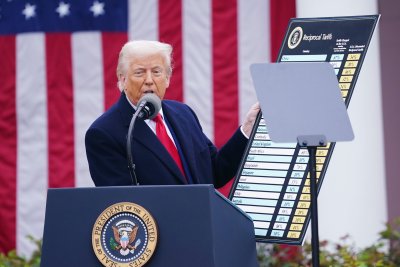
May 28 (UPI) — A three-judge panel on Wednesday struck down President Donald Trump‘s unilateral tariffs, including 10% imposed on most U.S. trading partners, calling them “contrary to law.”
Despite several lawsuits filed in different courts, this is the first time a federal court has blocked them.
The New York-based Court of International Trade, in a 49-page opinion, said the International Emergency Economic Powers Act does not give him the “unlimited” power to levy across-the-board tariffs.
The Trump administration can appeal the decision to the U.S. Court of Appeals for the Federal Circuit and, ultimately, the Supreme Court.
White House spokesperson Kush Desai said the U.S. trade deficits with other countries have “created a national emergency that has decimated American communities.”
“It is not for unelected judges to decide how to properly address a national emergency. President Trump pledged to put America First, and the Administration is committed to using every lever of executive power to address this crisis and restore American Greatness,” White House spokesperson Kush Desai said in a statement to CBS News.
The judges’ decision was based on two cases brought by a group of small businesses and 12 Democratic state attorneys general.
The judges were appointed by three presidents: Gary Katzmann by Barack Obama, Timothy Reif by Donald Trump and Jane Restani by Ronald Reagan.
“The President’s assertion of tariff-making authority in the instant case, unbounded as it is by any limitation in duration or scope, exceeds any tariff authority delegated to the President under IEEPA,” the judge wrote. “The Worldwide and Retaliatory tariffs are thus ultra vires and contrary to law.”
Separate tariffs against China, Canada and Mexico “do not deal with the threats set forth in those orders,” the court also found. These went into effect on March 4.
Trump imposed a 25% tariff against Canadian and Mexican goods, except for items compliant with the United States-Mexico-Canada, and 10% for energy and potash from the U.S. northern neighbor. China was hit with a 30% tariff.
The 10% duties went into effect on April 5.
The president has the right to impose tariffs, based on a 1970s court decision involving the Trading with the Enemy Act of 1917, which preceded the International Emergency Economic Powers Act.
The judges said the president’s tariffs do not meet the limited condition of an “unusual and extraordinary threat” that would allow him to act alone without approval by Congress.
“Because of the Constitution’s express allocation of the tariff power to Congress, we do not read IEEPA to delegate an unbounded tariff authority to the President,” they wrote. “We instead read IEEPA’s provisions to impose meaningful limits on any such authority it confers,” the ruling said.
Earlier this month, T. Kent Wetherell II, a district judge in Florida nominated by Trump, said the president has the authority on his own to impose tariffs, but opted to transfer the case to the Court of International Trade.
Several lawsuits have been filed since Trump announced the tariffs on April 2 as “Liberation Day.”
Trump also announced on April 2 plans for harsher tariffs against the so-called worst offenders but one week later he paused them for 90 days until July. They include ones against America’s greatest allies: 26% against India, 25% against South Korea, 24% against Japan and 20% against the 27 members of the European Union.
Trump also had announced a 125% tariff on top of 30% against China but he suspended that. He also excluded tariffs on electronic products in China but last week threatened a 25% one on Apple products not made in the United States.
Last week Trump suggested 50% tariffs on the EU by June but paused them until July 9 on Sunday.
The tariffs have rattled U.S. stocks.